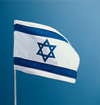|
Size:
20,770 sq. km

Location:
Middle East

Population:
5.74 million

Government:
Multiparty republic with one legislative house
(Knesset [120])

Capital:
Jerusalem

Head of Government:
Prime Minister Ehud Barak

Monetary Unit:
1 New (Israeli) sheqel (NIS) = 100 agorot; valuation (Sept. 25,
1998) 1 U.S.$ = NIS 3.85; 1 £ = NIS 6.55.

Official Languages:
Hebrew, Arabic

Ethnic composition:
Jewish 80.5%; Arab and other 19.5%.

Flag:


National Anthem:
Listen
to with RealAudio
|
Officially
STATE OF ISRAEL
, Hebrew
MEDINAT YISRA'EL
, Arabic
ISRA'IL
country in the Middle East, located at the eastern end of the
Mediterranean Sea. It is bounded to the north by Lebanon, to the
northeast by Syria, to the east and southeast by Jordan, to the
southwest by Egypt, and to the west by the Mediterranean Sea. The
total area is 7,992 square miles (20,700
square kilometers) excluding East Jerusalem and other territories
occupied in the 1967 war. Jerusalem is the capital and the seat of
government.
Following the
United Nations partition of Palestine, Israel declared independence
on May 14, 1948. It was the first Jewish state to be established in
nearly 2,000 years. Its creation represented a fulfillment of the
historic ideal of the Jewish people stemming from the traditional
religious belief in God's promise of the land of Israel to the
people of Israel. The ideal found practical expression in a desire
to forge a nation without dependence on the goodwill of others. The
establishment of Israel as a member of the family of nations
signified a decisive step in modern Jewish history.
Among the
population of Israel are hundreds of thousands of immigrants, many
of them survivors of Nazi persecution in Europe or victims of
anti-Semitism elsewhere. Israeli society has engaged in pioneering
activities, including the rehabilitation of neglected agricultural
lands. This has led to the creation of a Jewish rural population,
which, though it makes up only about one-tenth of the total, also
represents something almost unknown in the Diaspora (the historical
scattering of the Jews in countries outside of Palestine). The
revival of the Hebrew language has helped to make possible the
cultural integration of the newcomers.
Hostile relations
between Israel and its neighboring Arab states have prevailed from
the outset, with Israel obtaining victories over the Arabs after
battles fought in 1948-49, 1956, 1967, 1973, and 1982.
People

Languages |

Hebrew (official), Arabic used officially for Arab minority, English most commonly used foreign language |
|
Major Religions |
Judaism 82%, Islam 14% (mostly Sunni Muslim), Christian 2%, Druze and other 2% |
|
Ethnic groups |
Jewish 82% (Israel-born 50%, Europe/Americas/Oceania-born 20%, Africa-born 7%, Asia-born 5%), non-Jewish 18% (mostly Arab) (1993 est.) |
|
Growth rate |
1.91% |
|
Birth rate |
19.99 births/1,000 |
|
Death rate |
6.19 deaths/1,000 |
|
Fertility rate |
2.71 children/woman |
|
Male life expectancy |
76 |
|
Female life expectancy |
80 |
|
Infant mortality rate |
8.02 deaths/1,000 live births |
Economy

Labor force |

2.3 million (1997) |
|
Unemployment rate |
7.7% (1997) |
|
Inflation Rate |
9% (1997) |
Gross domestic product
(total value of goods and services produced annually) |
$96.7 billion (1997 est.) |
|
Budget |
$58.0 billion |
|
Debt |
$18.7 billion (1997) |
|
Exports
|
$20.7 billion (1997 est.), primarily machinery and equipment, cut diamonds, chemicals, textiles and apparel, agricultural products, metals |
|
Imports |
$28.6 billion (1997 est.), primarily military equipment, investment goods, rough diamonds, oil, consumer goods |
|
Defense spending |
9.5% of GDP (1997 est.) |
|
Highways |
15,065 km (1996) |
|
![]()
![]()
![]()

